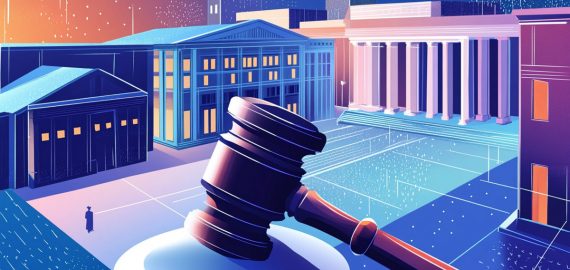Confronting the Challenge of AI-Created Imagery: The Importance of Staying Informed
In Brief
Globally, technology enterprises and governments have started putting strategies in place to protect citizens from the escalating threat posed by AI-generated visuals.

AI technology keeps merging reality with imagination, flooding our visual space—from marketing to entertainment—with incredibly realistic images. These images can be manipulated to misrepresent well-known figures, like politicians, thus spreading misinformation or propaganda.
What implications and worries arise with the increase of AI-generated imagery?
AI-generated visuals and videos present advantages, such as encouraging creativity and sparking innovation, but they also bring forth significant risks. Generative AI can create highly convincing images of events that never actually happened, making it a powerful tool for spreading false information and manipulating public opinion .
In the past six months, a form of AI Photography known as 'promptography,' as coined by Boris Eldgasen, has reached an unsettlingly high degree of realism.
Now, one can create images from simple text prompts that make the viewer doubt their genuineness. These AI-crafted images have fooled judges, secured wins in photography contests, and been manipulated by fraudsters during events like the earthquake in Turkey and Syria.
Technology giants and governmental bodies around the globe are beginning to introduce initiatives aimed at safeguarding the public from the rising threat of AI-generated images. Even photographers are starting to voice their unease, as the influx of AI in their field could blur the lines, making their unique work look similar to that of others.
A Growing Global Concern
Generative AI technologies are advancing at a swift pace, making it increasingly difficult to distinguish between computer-generated images, commonly termed 'synthetic visuals,' and those created without AI assistance.
The uniformity of AI-generated images poses a risk to the variety and creativity within the photography domain, complicating the task for photographers to assert their individuality and for audiences to recognize different photographers.
Moreover, if AI-generated visuals become commonplace, they could diminish the perceived value of photography. Images produced by AI may lose their uniqueness or allure, likely leading to lowered demand for original photographic works.
Concerns have been raised about the potential misuse of artificial intelligence tools to create abusive imagery and extremist propaganda, as the eSafety Commissioner of Australia recently highlighted the necessity for tech companies like Google, Microsoft's Bing, and DuckDuckGo to eliminate such content from AI-driven search tools.
This new industry standard for search engines requires these tech giants to remove child abuse materials from search results and implement safeguards to prevent the generation of misleading visuals of such content using generative AI.
Julie Inman Grant, the eSafety Commissioner, has emphasized the importance of tech companies taking proactive measures to reduce the risks associated with their products. She warned that fabricated child abuse content and extremist propaganda are already emerging, highlighting the urgency of tackling these challenges.
Microsoft and Google have unveiled plans to incorporate their AI solutions, ChatGPT and Bard, respectively, into their widely-used consumer search engines. Inman Grant mentioned that the rapid evolution of AI technology necessitates a reconsideration of the 'search code' that governs these platforms.
Microsoft analysts have reported that suspected Chinese operatives are leveraging artificial intelligence to emulate American voters online and spread disinformation concerning contentious political topics as the 2024 U.S. elections approach.
In the last nine months, these operatives have circulated striking AI-generated images portraying the Statue of Liberty and the Black Lives Matter movement on social media, primarily targeting to discredit American political figures and symbols.
This purported Chinese influence network has used numerous accounts on Western social media platforms to share AI-generated visuals. Despite being artificially created, genuine individuals have unintentionally amplified their reach by sharing them online.
Tech Companies Collaborate to Ensure Image Authenticity
Thomson Reuters, a content and technology firm, has teamed up with Canon and Starling Lab, an academic research laboratory, to initiate a pilot program aimed at validating the authenticity of images used in news journalism. This collaborative effort seeks to prevent AI-generated images from being misrepresented as actual photographs, particularly in news reporting where accuracy is essential.
This initiative is crucial in the fight against the alarming rise of misinformation. Rickey Rogers, Global Editor of Reuters Pictures, underlined the critical necessity of trust in news dissemination.
"Trust in news is fundamental. Nevertheless, the recent advances in technology, along with the potential for manipulation, make more people doubt the integrity of visual content. Reuters is dedicated to exploring innovative technologies that ensure the precision and reliability of the information we provide,\" Rogers stated. image generation Similarly, Google has introduced SynthID, a tool designed for watermarking and recognizing AI-generated images, and has launched its beta version in partnership with Google Cloud. This technology embeds an imperceptible digital watermark at the pixel level for verification.
Imagen, one of the cutting-edge text-to-image models, is now making SynthID available to select Vertex AI clients. Imagen converts textual prompts into photorealistic images with stunning results.
Researchers crafted SynthID to uphold image quality while ensuring the watermark remains detectable even after modifications such as filters, color adjustments, or compression, often characteristic of JPEG formats.
SynthID employs two sophisticated deep learning frameworks—one for watermarking and the other for identification—trained on diverse photo datasets. The unified model is meticulously calibrated to achieve multiple aims, including accurately identifying watermarked data and ensuring aesthetic compatibility of the watermark with the original image.
Addressing this issue requires concerted efforts from photographers, AI developers, and the wider photography community. This could involve establishing ethical standards and best practices for integrating AI into photography, encouraging the exploration of novel photography styles that utilize the unique capabilities of AI while safeguarding the artistic essence of the discipline.
, please remember that the information presented on this page is not meant to serve as, nor should it be interpreted as, legal, tax, investment, financial, or any other form of advice. It’s crucial to only invest what you can afford to lose and seek independent financial counsel if you have any uncertainties. For additional insights, we recommend reviewing the terms and conditions as well as the help and support sections provided by the issuer or advertiser. MetaversePost is committed to delivering accurate, impartial reporting, but remember that market situations can change without prior notice.
Disclaimer
In line with the Trust Project guidelines Victor serves as a Managing Tech Editor/Writer at Metaverse Post, focusing on topics like artificial intelligence, cryptocurrency, data science, metaverse developments, and cybersecurity in enterprise contexts. With five years of experience in media and AI, he has worked with prominent outlets such as VentureBeat, DatatechVibe, and Analytics India Magazine. Having also served as a Media Mentor at esteemed institutions including Oxford and USC, and holding a Master’s degree in data science and analytics, Victor is dedicated to staying updated on emerging trends.







